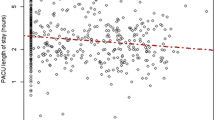Abstract
Background
Ward-based patient-controlled epidural analgesia (PCEA) for postoperative pain control was introduced at our institution in 2006. We audited the efficacy and safety of ward-based PCEA from January 2006 to December 2008.
Method
Data were collected from 928 patients who received PCEA in general surgical wards for postoperative analgesia using bupivacaine 0.125% with fentanyl 2 μg/mL.
Results
On the first postoperative day, the median visual analogue pain score was 2 at rest and 4 on activity. Hypotension occurred in 21 (2.2%) patients, excessive motor blockade in 16 (1.7%), high block in 5 (0.5%), nausea in 5 (0.5%) and pruritus in only 1 patient. Excessive sedation occurred in two (0.2%) patients but no intervention was required. There were no serious complications such as epidural abscess, infection or haematoma.
Conclusion
Effective and safe postoperative analgesia can be provided with PCEA in a general surgical ward without recourse to high-dependency supervision.


Similar content being viewed by others
References
Werawatganon T, Charuluxanun S (2005) Patient-controlled intravenous opioid analgesia versus continuous epidural analgesia for pain after intra-abdominal surgery. Cochrane Database Syst Rev CD004088
Wu CL, Cohen SR, Richman JM et al (2005) Efficacy of postoperative patient-controlled and continuous infusion epidural analgesia versus intravenous patient-controlled analgesia with opioids: a meta-analysis. Anesthesiology 103:1079–1088 quiz 109-10
Ballantyne JC, Carr DB, DeFerranti S et al (1998) The comparative effects of postoperative analgesic therapies on pulmonary outcome: cumulative meta-analyses of randomized, controlled trials. Anesth Analg 86:598–612
Modig J (1989) Influence of regional anesthesia, local anesthetics, and sympathicomimetics on the pathophysiology of deep vein thrombosis. Acta Chir Scand Suppl 550:119–124 discussion 24-7
Jorgensen H, Wetterslev J, Moiniche S, Dahl JB (2000) Epidural local anaesthetics versus opioid-based analgesic regimens on postoperative gastrointestinal paralysis, PONV and pain after abdominal surgery. Cochrane Database Syst Rev CD001893
Barratt SM, Smith RC, Kee AJ, Mather LE, Cousins MJ (2002) Multimodal analgesia and intravenous nutrition preserves total body protein following major upper gastrointestinal surgery. Reg Anesth Pain Med 27:15–22
Beattie WS, Badner NH, Choi P (2001) Epidural analgesia reduces postoperative myocardial infarction: a meta-analysis. Anesth Analg 93:853–858
Van der Vyver M, Halpern S, Joseph G (2002) Patient-controlled epidural analgesia versus continuous infusion for labour analgesia: a meta-analysis. Br J Anaesth 89:459–465
Liu SS, Allen HW, Olsson GL (1998) Patient-controlled epidural analgesia with bupivacaine and fentanyl on hospital wards: prospective experience with 1,030 surgical patients. Anesthesiology 88:688–695
Scott DA, Beilby DS, McClymont C (1995) Postoperative analgesia using epidural infusions of fentanyl with bupivacaine. A prospective analysis of 1,014 patients. Anesthesiology 83:727–737
Broekema AA, Gielen MJ, Hennis PJ (1996) Postoperative analgesia with continuous epidural sufentanil and bupivacaine: a prospective study in 614 patients. Anesth Analg 82:754–759
Wigfull J, Welchew E (2001) Survey of 1,057 patients receiving postoperative patient-controlled epidural analgesia. Anaesthesia 56:70–75
Motamed C, Farhat F, Remerand F et al (2006) An analysis of postoperative epidural analgesia failure by computed tomography epidurography. Anesth Analg 103:1026–1032
Acknowledgments
We would like to thank Professor Harald Breivik for his expert advice on the project. There was no grant or funding provided for this project.
Conflict of interest
There is no conflict of interest for all of the authors.
Author information
Authors and Affiliations
Corresponding author
Appendix
Rights and permissions
About this article
Cite this article
Tan, T., Wilson, D., Walsh, A. et al. Audit of a ward-based patient-controlled epidural analgesia service in Ireland. Ir J Med Sci 180, 417–421 (2011). https://doi.org/10.1007/s11845-010-0645-5
Received:
Accepted:
Published:
Issue Date:
DOI: https://doi.org/10.1007/s11845-010-0645-5




